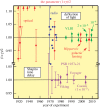Bending space-time: a commentary on Dyson, Eddington and Davidson (1920) 'A determination of the deflection of light by the Sun's gravitational field'
- PMID: 25750149
- PMCID: PMC4360090
- DOI: 10.1098/rsta.2014.0287
Bending space-time: a commentary on Dyson, Eddington and Davidson (1920) 'A determination of the deflection of light by the Sun's gravitational field'
Abstract
The famous eclipse expedition of 1919 to Sobral, Brazil, and the island of Principe, in the Gulf of Guinea, led by Dyson, Eddington and Davidson was a turning point in the history of relativity, not only because of its importance as a test of Einstein's General Theory of Relativity, but also because of the intense public interest which was aroused by the success of the expedition. The dramatic sequence of events which occurred is reviewed, as well as the long-term impact of its success. The gravitational bending of electromagnetic waves by massive bodies is a subject of the greatest importance for contemporary and future astronomy, astrophysics and cosmology. Examples of the potential impact of this key tool of modern observational astronomy are presented. This commentary was written to celebrate the 350th anniversary of the journal Philosophical Transactions of the Royal Society.
Keywords: Eddington; eclipse expedition 1919; general relativity; gravitational lensing; light bending by the Sun.
Figures




Similar articles
-
The birth of the electric machines: a commentary on Faraday (1832) 'Experimental researches in electricity'.Philos Trans A Math Phys Eng Sci. 2015 Apr 13;373(2039):20140208. doi: 10.1098/rsta.2014.0208. Philos Trans A Math Phys Eng Sci. 2015. PMID: 25750145 Free PMC article.
-
Gravitational lensing: a unique probe of dark matter and dark energy.Philos Trans A Math Phys Eng Sci. 2010 Mar 13;368(1914):967-87. doi: 10.1098/rsta.2009.0209. Philos Trans A Math Phys Eng Sci. 2010. PMID: 20123743 Free PMC article.
-
[History and memory on glass: the Brazilian photographs of the 1919 eclipse in Sobral].Hist Cienc Saude Manguinhos. 2020 Jul-Sep;27(3):983-1000. doi: 10.1590/S0104-59702020000400015. Hist Cienc Saude Manguinhos. 2020. PMID: 33111799 Portuguese.
-
Gravitational Lensing in Astronomy.Living Rev Relativ. 1998;1(1):12. doi: 10.12942/lrr-1998-12. Epub 1998 Nov 2. Living Rev Relativ. 1998. PMID: 28937183 Free PMC article. Review.
-
Fundamentals of numerical relativity for gravitational wave sources.Science. 2018 Jul 27;361(6400):366-371. doi: 10.1126/science.aat3363. Epub 2018 Jul 26. Science. 2018. PMID: 30049876 Review.
References
-
- Longair M. 2003. Theoretical concepts in physics Cambridge, UK: Cambridge University Press.
-
- Longair M. 2006. The cosmic century Cambridge, UK: Cambridge University Press; (2013 revised paperback edition)
-
- Pais A. 1982. Subtle is the lord: the science and the life of Albert Einstein Oxford, UK: Clarendon Press.
-
- Stachel J. 1995. The history of relativity In Twentieth century physics, vol. 1 (eds LM Brown, A Pais, AB Pippard) pp. 249–356. Bristol, UK: Institute of Physics Publishing; New York: American Institute of Physics Press.
-
- Ishiwara J. 1923. Einstein Kyôju kouen-roku Tokyo, Japan: Tokyo-Toshu; [In Japanese.] This contains Einstein's Kyoto address of December 1922. An English translation is included in: Akibo S. 2000 Einstein's Kyoto address ‘How I Created the Theory of Relativity’. Hist. Stud. Phys. Biol. Sci. 31, 1–35. The quotations are on pages 15–16 in a slightly different translation
LinkOut - more resources
Full Text Sources
Other Literature Sources

